
Seed Cabinet
by KATERIE GLADDYS, ANNA PRIZZIA and MELISSA DESA
- View Katerie Gladdys 's Biography
Katerie Gladdys is an artist and Associate Professor in Art and Technology in the School of Art and Art History at the University of Florida.
- View Anna Prizzia's Biography
Anna Prizzia oversees the UF/IFAS College of Agricultural and Life Sciences Field and Fork Program at the University of Florida and is Board President of Working Food, a non-profit focused on supporting and sustaining local food efforts in North Central Florida.
- View Melissa DeSa's Biography
Melissa DeSa, a self-taught “farmdener", is Community Programs Director of Working Food and SeedEO of the Souther Heritage Seed Collective in Gainesville, FL where she teaches about local food, gardening and seed saving.
Seed Cabinet
by KATERIE GLADDYS, ANNA PRIZZIA and MELISSA DESA
Living democracy grows like a seed, from the ground up. - Vandana Shiva
Seeds represent the essence of life. They contain all necessary information needed to feed a community. Local cultures determine what seeds get saved, what crops get propagated. As food moves through different cultures, communities and ecological environments it becomes site-specific; the values and taste of the places where they are grown impact selection. Seed libraries protect seed varieties adapted to specific geographic regions, and train community members and growers on seed saving techniques. Seed libraries, which are on the rise nationwide, function simultaneously as repositories of genetic diversity and local knowledge, which is particularly important as society wrestles with food security and sovereignty.
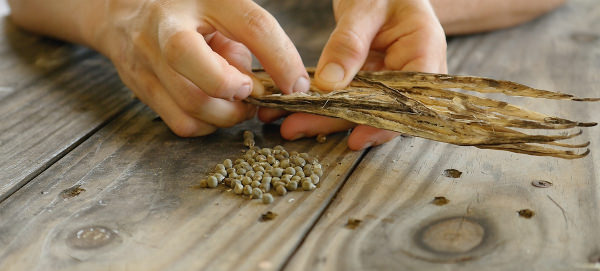
Using the metaphor of the seed as an agent of exchange and expression of community, culture and place, "Seed Cabinet" is an interactive exhibition of images, stories and seeds, treating the audience to a sensory experience of our food system. Sustainable local food activists, Anna Prizzia and Melissa DeSa of Forage's Southern Heritage Seed Collective and myself are collaborating on an interactive and interpretive road show style performance and a portable, electronic cabinet of curiosity filled with seeds and their stories. "Seed Cabinet" seeks to invite the public to cultivate a personal relationship with local agriculture.
Socially engaged art and pedagogy about local food systems provides context for our collaboration. We are inspired by works such as Seed Journey by Future Farmers. The art and design collective, working with The Flatbread Society, sailed from Northern Europe to Turkey, gathered historic grain seeds along the way in order to reverse migrate the European seeds back to sites of historic grain domestication. Åsa Sonjasdotter's installations that raise awareness of the colonial histories of local food staples such as potatoes also inform our work. We feel particular kinship with Jeanette Hart Mann and Chrissie Orr. SeedBroadcast is a repurposed bread truck that houses the Mobile Seed Story Broadcasting Station. In addition to collecting stories about open pollinated seeds, SeedBroadcast serves as a resource for communities to learn about the interconnected ecology of rural and urban food systems.
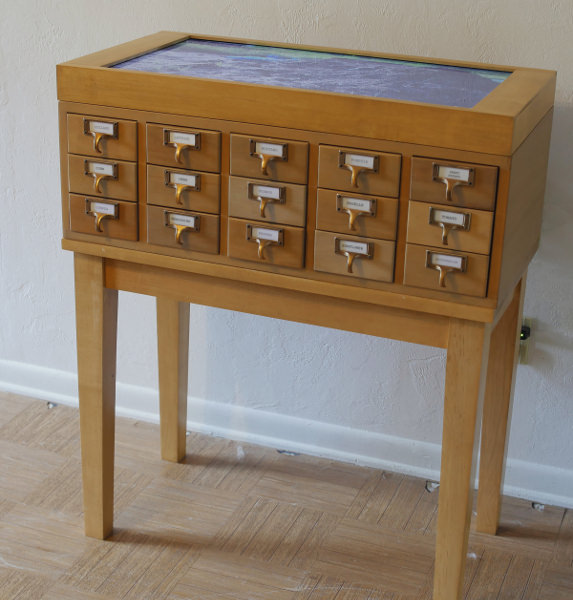
Old + New Technology X Pedagogy
Card catalogs, glass slides, and preserved specimens are obsolete yet very familiar cultural objects which, when activated by and hybridised with performance, video and electronics, bring together multiple ways of knowing, disrupting and playing with the audience's expectations of library, archive, and machine. In the tradition of the Wunderkammer, the drawers of a repurposed "old school" maple card catalog are filled with seed specimens of regional heritage fruits and vegetables and images printed on glass slides. Rare earth magnets in reed switches are attached to the back of the card catalog drawer and the back of the card catalog proper. When the participant pulls open the drawer, the connection between the magnets is severed sending a message to a Raspberry Pi microcomputer running a program called Pi Presents. The disconnection triggers a change in video. Each drawer is associated with a particular vegetable video. Simultaneously, when a drawer is opened a photo resistor is exposed to light. Again, the change in current is a switch that "turns on" backlights that illuminate a resin block impregnated with seeds and a glass slide printed with an image of the drawer's vegetable. The juxtaposition of the natural materials of the seeds and the printed glass slide with the apparatus of the circuit suggests to the viewer the pervasiveness of human intervention vis á vis technology and the domestication of plants and animals. Opening the drawers triggers the playing of poetic videos and audio narratives of our community's lived experience of these foods: their cultivation, preparation, and history onto a video monitor embedded into the top of the card catalog.
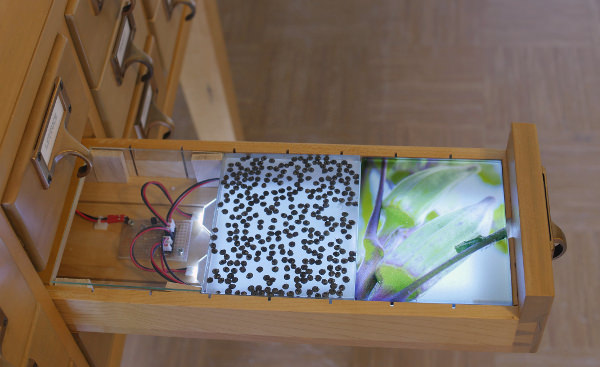
Seed Cabinet is a form of "pedagogy" where the meat (or vegetables in this instance) and the meta coexist and dialog with one another through the interaction of the audience. Seed Cabinet sows the seeds for dialog between both novices and experts in gardening inviting people to literally play with a card catalog. Seed Cabinet is a collision point that remixes the discourse of how technical information is dispersed blending live "lecture" with oral history, filmic instructional media, cooking shows, experimental ethnography, animation and at times even kitsch. Seed Cabinet includes facts but resembles the discourse of science as a way to share information about and problematize seeds, inviting the audience to reflect upon their role in both global and local food systems.
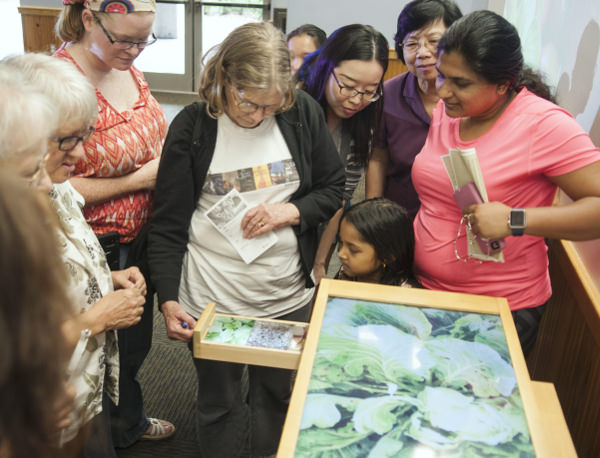
Nostalgia and Community
Seed Cabinet evokes the nostalgia and spectacle of state fairs and agricultural expositions of the 19th century - the biggest pumpkin, the perfect rose, grandma's prize-winning tomato. The piece engages the audience with interactive technologies, riffing on the pedagogical strategies of cooperative extension that brought "innovative" farming methods to rural constituents through demonstrations within the community. We collaborated with the Matheson History Museum to create complementary resource materials featuring images from the museum's extensive postcard collection. These postcards, many of which are more than a century old, feature unnaturally large fruit and vegetable specimens and agricultural tableau vivant in order to promote Florida as an Edenic paradise to tourists and future residents as Florida developed. When possible, we distributed free seeds from the Southern Heritage Seed Collective to the public.
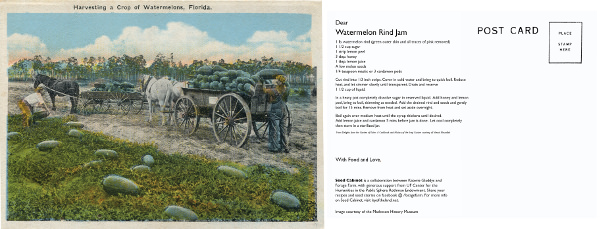
Process and Collaboration
The methodology used to research and document the fruits and vegetables of Seed Cabinet recalls the journeys and encounters that contextualise the specimens of the herbarium. I traveled throughout Alachua County and beyond collecting images, videos and stories of human interaction with the land through farming and gardening. As an artist, the process of creating involved becoming acquainted with the people who research, produce and prepare food in my community. I visited and shot video at many local farms - The Family Garden, Forage Farm, University of Florida Plant Science Research and Education Unit, University of Florida Community Farm and the Alachua County Farm to School Work Hub.
Below is a collection of some of the experiences that informed the making of Seed Cabinet.
I gazed at fragments of sticks and branches and rusty bits of metal - a dibble passed down over three generations, bits of a Native American rabbit snare recovered from a dredged pond, antique scissors now dull - intermingled with four generations of family photographs at Mr. Feaster's homestead. I listened to him talk about encroaching retirement housing from the south and his work to have his family's land designated as "Pioneer Farm" by the state of Florida. Mr. Feaster spoke of The Feaster Family Heirloom Mustard, a registered heirloom variety of mustard green, that grows prolifically sprouting through the cracks in his driveway in addition to more formal plantings in his garden where domesticated wild pigs rooted out and snacked on nut sedge, biodynamically clearing the land of an invasive and competitive weed.
Mr. Henderson and Dr. Diane Rowland both are passionate about peanuts. Mr. Henderson's boiled peanuts grace the farmer market in the fall and winter and are game time sustenance for football fans at University of Florida matches. On his farm, Mr. Henderson watches as predatory yet, majestic Sandhill cranes forage his growing peanuts. Dr. Rowland, working as a faculty researcher at the Institute of Food and Agricultural Sciences deprives peanuts of water, training them to grow in drought conditions, documenting their root growth with delicate images of white finger like structures reaching for moisture.

I watch a hurricane slowly approach as I film vines laden with muscadine and scuppernong grapes at Royal Manor Vineyard, feeling the changes in barometric pressure as the first rains approach.
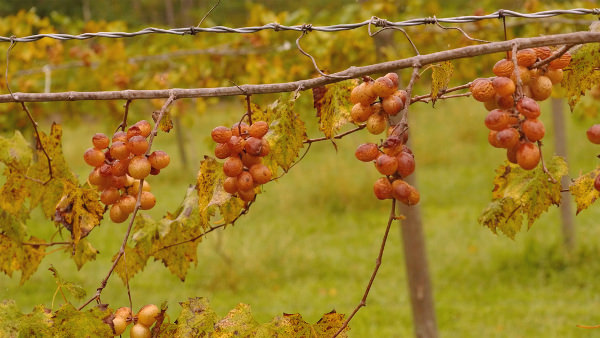
I document the sun rising over a cowpea field. I record children and parents shelling dried cowpeas. I am aware of regional accents of the southeastern US, listening to men read a list of 25 varieties of cowpeas grown in the 1840's as compared to one lone variety in the 2017 Burpee Seed online catalog.
Anna shows me a device to pop the calyxes off of Roselle. Melissa rhythmically beats dried lettuce flowers against the side of a plastic bin to separate the seeds from the plant.

At Old Florida Museum in Saint Augustine, FL (oldest continuously settled US city) I learn to grind corn pounding it with a giant wooden pestle. I also grind corn using a metate. I visit Panhandle Pioneer Settlement and observe 100 years of corn grinding technology over the course of an hour. Mr. Willard Smith is a visionary. Mr. Smith has taken over part of the county park and created a tourist attraction from abandoned buildings. He moves, collects and restores the old homesteads and buildings in Calhoun County, FL. The descendants return to their relocated ancestral homes and barns to talk to tourists on the weekends.
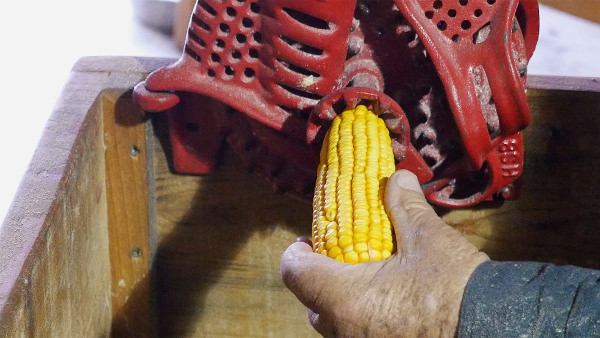
I bake and document seven varieties of corn bread. Four of them are edible.
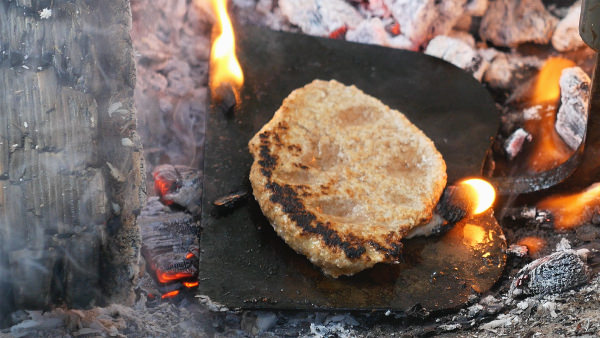
Intention and Setting
In Spring 2017, Seed Cabinet traveled to ten of the twelve public libraries in rural Alachua County, Florida. Seed Cabinet also was shown at Swallowtail Farms Spring Festival and the Marion County Land Preservation Festival. Deliberate also was our initial decision to bring Seed Cabinet to our local libraries. Card catalogs, glass slides, and tangible specimens are obsolete yet very familiar cultural objects which, when activated by and hybridised with performance, video and electronics bring together multiple ways of knowing and simultaneously disrupting and playing with the audience's expectations of library, archive, and machine. Our original intention was for library patrons to come together and participate in a "class" on seed saving, engage with a hybrid analog/digital apparatus (Seed Cabinet) listening, and watching stories about plants and seeds from the perspectives of growers, consumers and the plants themselves, while also, sharing their experiences and questions about seed saving and sustainable gardening.
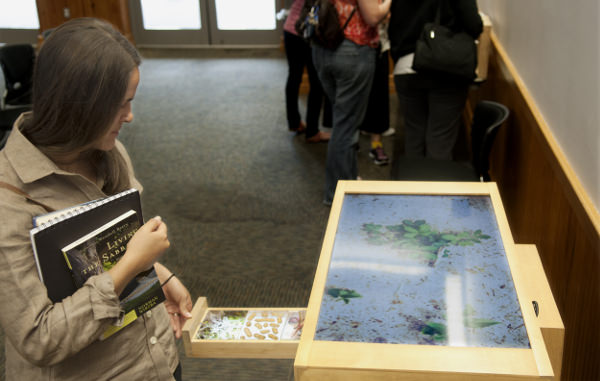
Anecdotal Site-specificity
The seed saving workshops and exhibition of the piece are evolving and site-specific. At one library, we partnered with Alachua County Extension's Vegetable Cooking Club program where some of the vegetables in the Seed Cabinet were featured in the demonstrated recipe. At one of the most rural library branches, Seed Cabinet was part of a monthly gardening program that functions as a social gathering for senior citizens. In our original proposal, we anticipated our audience to be adults. Learning that at least two of our gigs were to be predominantly children from underserved communities, we added snacks such as peanuts, sunflower seeds and popcorn, taught small scale winnowing of seed and how to examine seeds under a microscope. We also came up with a game where the audience was given tags with the names of the vegetables in the cabinet and invited to collaboratively label the drawers of the card catalog. This exercise served to generate conversation and facilitate an atmosphere of sharing. Each place we visited was a little different. At some venues, people heard we were giving away free seed and were not so interested in the art. Other times, some of the participants passed out seeds from their own gardens. Memories were shared especially at workshops where the population spanned generations. The presentation was a catalyst for a grandfather to tell his grandchildren about the decline of bees in the yard. A woman told a tale of tomato-flavoured honey, created when the seeds of the waste tomatoes from a local farm stand grew a field of unplanned tomatoes the following year nearby to her family's bee hives. At the Land Preservation festival, farmers already familiar with the vegetables were curious about the technology of the reed switches controlled by a Raspberry Pi microcomputer triggering video. Recent immigrants were excited at the prospect of finding seed for Roselle aka Florida Cranberry aka Flor de Jamaica and bringing the seed back to grow in a community garden in a neighbouring city. Watermelons that flourish in the Florida heat and humidity such as Ali Baba, a watermelon variety rescued from the war in Iraq, found its way into gardens across the political spectrum.
Challenges and Future Experiments
After the first tour of Seed Cabinet and Seed Saving 101 workshop, we reflected upon the following questions:
- How could we better engage the most precarious communities with respect to food security and sovereignty?
- Although there were library branches in the underserved neighbourhoods of our county, was the library the best venue? For future iterations, we plan to reach out to faith-based outlets such as churches and radio stations, neighbourhood restaurants and grocery stores through networking and strategically placed print media.
- The elderly constituted a significant percentage of the audience. Sometimes they had problems in hearing the presentation on seed saving and the audio of the seed cabinet.
- Many high schools in the area have student-run gardens and farms. This was an audience that we did not consider.
- We also thought more about what constituted our target audience? We came up with three groups broadly defined. 1. People who do not know how to grow their own food, 2. People who are growing food, but do not save seeds, and may be encouraged to plant local and better climatically suited varieties of vegetables using more sustainable methods, and 3. People who are experts curious about the project and willing to share their knowledge.
- Important too was helping the audience to discern the difference between heirloom, local, hybrid, and heritage. We plan to develop another interactive activity to generate a dialog and invite the audience to think conceptually about seeds and vegetables as fluid cultural agents. What constitutes an heirloom variety? Whose heritage? Most vegetables are immigrants.
- Increasing the breadth of the audience's sensual experience by employing taste and smell-bringing samples of food made with the fruits and vegetables in the Seed Cabinet.
- The fellowship of the workshop and the artwork as a curious often stimulated dialog. The videos of the Seed Cabinet were varied in their format ranging from oral histories to video collage. At times we needed to better facilitate transition in conversation when watching less narrative more conceptual videos. How do we create balance and flow between the narrative in the work, the stories we tell as performers and the stories shared by the audience. Connected to dialog with one another was figuring out how to encourage the audience to move past the spectacle of interactive technology and spend more time with the work.
- Framing the experience historically as an alternative version of cooperative extension. In the southern US at the beginning of the 20th century, women were tasked with going out into the community to promote nutrition and new technologies such as vacuums, mixers, blenders etc. We saw analogies between using technology and art as a way to evangelise about sustainability and food.
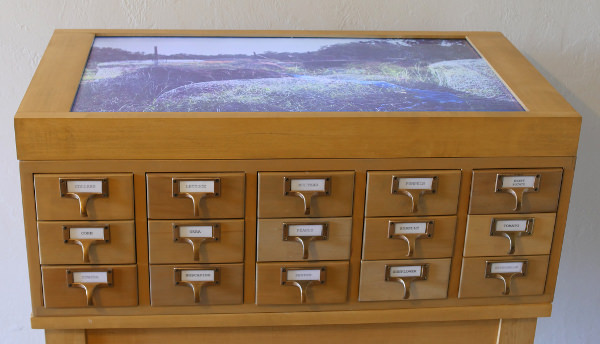
Seed Cabinet is an interface that facilitates conversation around both the seed saving demonstration and the virtual experience created by video and electronics, that then is potentially manifested not only in the action of planting a backyard garden using seeds native to our area but with the understanding of the human and natural history context of these particular seeds. We seek to inform and inspire the public to cultivate a personal relationship with local agriculture and realise the power of democracy in food systems.
Project Personnel
Melissa DeSa is a self-taught farmdener (bigger than a gardener, smaller than a real farmer) and avid seed saver, with a background in wildlife ecology. She manages Forage, a non-profit organisation, in Gainesville, FL where she teaches about local food, gardening and seed saving.
Katerie Gladdys is an associate professor in Art and Technology in the School of Art and Art History at the University of Florida. She examines place, marginalised landscapes, sustainability, mapping, consumption, food, agriculture, and disability creating installations, interactive, sculpture, video, and relational performances. Recent partners in collaboration include School of Forest Resource and Conservation, University of Florida Office of Sustainability and Institute of Food and Agricultural Sciences Center for Public Issues and Education and the Gainesville community.
Anna Prizzia is the co-founder of Forage, the local non-profit that hosts the Southern Heritage Seed Collective. Anna also works as the UF Campus Food Systems Coordinator and serves on the board of Blue Oven Kitchens.
Works cited
Ferris, Marcie Cohen. Edible South: The Power of Food and the Making of an American Region. Chapel Hill, NC: U of North Carolina, 2016. Print.
Flatbread Society Seed Journey, 2017, Web.
Potato Perspective, 2017, Web.
Ray, Janisse. The Seed Underground: A Growing Revolution to save Food. White River Junction, VT: Chelsea Green, 2013. Print.
SeedBroadcast, 2017, Web.
Shields, David S. Southern Provisions: The Creation and Revival of a Cuisine. Chicago: U of Chicago, 2016. Print.

